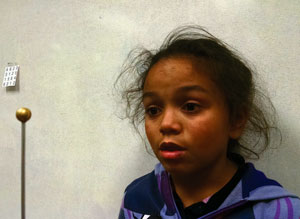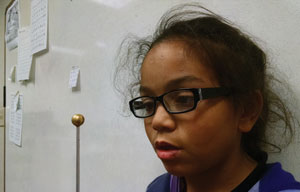|
|

|
This is the first installment of a bimonthly column dedicated to topics in refraction and binocular vision. We’ll bring you actual cases that we’ve seen and explain how we handled them, and we’ll also answer case-based questions from readers. We’re thrilled to cover optometry’s stock-in-trade, and hope that it generates thought and perhaps even a little controversy.
Please send any feedback or ideas for future columns to Marc Taub, OD, MS, at mtaub@sco.edu.
I (Marc) was hosting my son’s eighth birthday party at my house and, amid the chaos, I noticed that one of the girls was blinking excessively. It didn’t seem to matter much what she was looking at, distance or near, but she was literally blinking every few seconds. Not only was she blinking unusually often, but she was also blinking fairly hard, and seemed bothered when she had to do so.
As the party wound down, I questioned her mother, who said the girl’s excessive blinking had been going on for the past two months. She was doing well in school and had no trouble with reading or copying from the board. Her mother also revealed that her daughter had started medication for attention deficit hyperactivity disorder (ADHD) four months prior.

|
|
| Our young, blinking patient showed a reduced near point of convergence. |
|
When I suggested the girl have an eye exam, the mother stated her daughter needed to see a local pediatric ophthalmologist first due to a family obligation. I explained the differences in approach, and asked her to let me know the outcome of that examination. I told the mother that the examination would not likely produce an explanation for the blinking, as ophthalmologists do not routinely test beyond sight-related issues.
Diagnostic Data
After the pediatric ophthalmologist’s examination showed that the child did not need glasses and that she did not have a visual acuity-based issue, she came into our clinic for a second examination with a focus on binocular vision and accommodation.
Her history included the Quality of Life Symptoms checklist, which we use to gauge the impact of the potential visual issue. She scored a four; a score of 20 or greater is considered a red flag. While her score didn’t correlate with the subsequent examination data, it was not surprising—whatever was occurring wasn’t affecting her academically or causing an inordinate amount of symptoms. As this was only one piece of the examination puzzle, I pressed on.
Her visual acuity was 20/20 OD and OS at distance and near. Stereopsis, which is a great way to assess fine binocular functioning, was 25 seconds of arc. Cover test was orthophoric at distance and 6 prism diopters of exophoria at near. Extraocular muscle testing revealed head movement in right and left gazes, and heavy blinking when crossing the midline.
The near point of convergence (NPC) broke at 40cm three times and her accommodative amplitudes were 6.00D OD and OS. Distance retinoscopy was -0.50 OD and -0.25 OS, and near retinoscopy by monocular estimated method (MEM) was +1.00 OU.
Diagnosis and Management
Based on her normal visual acuity, low minus on dry retinoscopy, and lag on MEM, we decided to trial frame +0.75D OU.
|
|

|
|
|
With lenses in place, her near point of convergence improved—and the frequent blinking soon stopped. Most likely, the blinking was essentially a symptom of a pseudo-convergence insufficiency. |
Besides witnessing an immediate positive subjective response, the following testing was performed with the trial frame in place:
- Phoria: orthophoria @ distance, 4 exophoria @ near
- NPC: 8cm break/18cm recovery
The subjective difference and the improvement in the NPC and near phoria with the low plus prescription lead to a diagnosis of pseudo-convergence insufficiency. What differentiates this condition from true convergence insufficiency is the improvement in the NPC and reduced exophoria at near with the plus lenses.
The blinking was essentially a symptom of the pseudo-convergence insufficiency; she was apparently attempting to clear the image as the planes of accommodation and vergence were constantly shifting. Also, the patient had recently started medication for ADHD. Both ADHD and some of the medications used to treat it are known to cause visual disturbances related to visual acuity, accommodation and vergence; however, it’s unclear if the medication played a part in these findings.1,2
We decided on a full-time prescription of +0.75D and scheduled the patient return in five to six weeks to assess the impact.
|
Clinical Pearl
If you suspect your patient has convergence insufficiency, with low plus in place, retest the near point of convergence, cover test and stereopsis again. If there is a positive change (improved NPC, reduced exophoria on cover test and/or improved stereopsis), consider prescribing the lenses; the patient may actually have a pseudo-convergence insufficiency. |
|
You may ask: Why prescribe full-time and not near only? We’ve found it a hassle for the patient to constantly be taking the glasses on and off, so we solve this issue by leaving them on. Also, this patient and her mother wanted no part of a bifocal. At the two-month follow-up, both the mother and child reported that she complied with the use of the glasses and that the blinking stopped within days of wearing them. Her visual acuity remained excellent at 20/20 OD and OS at distance and near both with and without the glasses on. Stereopsis was 20 seconds of arc. Cover test was orthophoria at distance and 4 exophoria at near. NPC was “to the nose” three times.
Since that first visit, we’ve seen her several times. The blinking has dissipated and not returned. She is still wearing the glasses for school and homework. We’ll evaluate her need for the glasses on a yearly basis with a full eye examination, including binocular vision and accommodative testing.
When looking at this case, we see a girl in visual distress, which was alleviated with low plus lenses. The key to this case was performing a basic evaluation of near functions both with and without the tentative prescription in place. We found an immediate response on the cover test and more so with the NPC. Without these data points, we would not have been able to offer the proper treatment.
1. Grönlund MA, Aring E, Landgren M, Hellström A. Visual function and ocular features in children and adolescents with attention deficit hyperactivity disorder, with and without treatment with stimulants. Eye (Lond). 2007 Apr;21(4):494-502.2. Concerta prescribing information. Janssen Pharma-ceu-ticals, Inc. Dec 2013. Available at: www.concerta.net/adult/prescribing-information.html.

